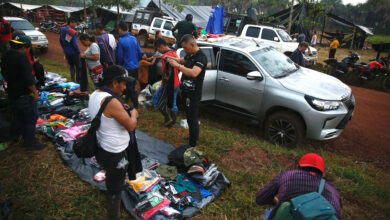5 Years after war’s end, Colombians see few gains from peace

By Irene Escudero
Pesquera, Colombia, Nov 20 (EFE).- Residents of this riverside hamlet in eastern Colombia that was a rebel redoubt during the country’s internal conflict are accustomed to getting dirty looks and being called guerrillas when they tell people they are from Pesquera.
And as Colombia prepares to mark the fifth anniversary of the peace accord between the government and the largest insurgency, the FARC, inhabitants here say that the end of the decades-long conflict has not led to a material improvement in their lives.
One day as the sun was going down over the Arauca River, some of the local women took advantage of the cooling of the air to venture out of their homes and chat.
Graffiti from the FARC and the smaller ELN group – which has yet to lay down its arms – continue to adorn walls in Pesquera, but the vice president of the Communal Action Board, Edelmira Suarez, assured Efe that there is no longer a rebel presence.
“There are guerrillas, but not here in Pesquera,” she said.
Suarez, whose family settled here after being displaced from their home on the Caribbean coast, has survived two brushes with bullets, most recently in 2019 during an ELN attack on a fuel pipeline that runs through the village, while her youngest daughter narrowly escaped harm when she was caught in the middle of a gunfight while fishing in the river.
Asked whether peace has changed anything, she said: “We experienced a brief period of calm before and after the signing (of the accord), and what came later is not what they promised.”
“Don’t be fooled,” Suarez said, pointing to a new clinic.
The interior is “anti-hygienic” and no permanent doctor assigned to the post, she said.
“When there is no institutional presence of the state in social investment, in attention to population’s needs, unfortunately the armed groups exercise authority,” said Ariel Pedraza, president of the Communal Action Board in Puerto Nariño, Arauca province.
Yesid Robles, with the Provincial Human Rights Network, spoke of Colombia’s inadequate approach to public health and called the educational system a “catastrophe.”
In Pesquera, many children give up their studies in adolescence because the nearest secondary school is an hour’s walk on dirt roads that turn to mud in the rainy season.
Lack of opportunities and abandonment by the state create a perfect breeding ground for criminal gangs, paramilitaries and FARC renegades.
The problem is not limited to Arauca. Communities across Colombia have yet to see any signs that the formal end of the conflict that began in the mid-1960s will translate into development.
“And every time we complain about the absence of the state, the response is not social investment or institutional presence to fill vacuums, but rather military presence, the increase of troops, more rifles, more armored vehicles,” Pedraza said.
In the absence of the state, people in communities like Pesquera have created a strong, resilient social fabric, reflected in the proliferation of councils and civic organizations.
The people who serve in those bodies are well aware that asking for justice – or for something as mundane as streetlights – can expose them to the risk of joining the 1,266 activists who have been slain in the last five years.
Another community leader in Arauca, Adenis Contreras, said that the Colombian government “wants to humanize war to continue it, not to end it.”
“It wants war to be part of our life and for us to assimilate our fallen family members as something normal,” he said. EFE ime/dr





